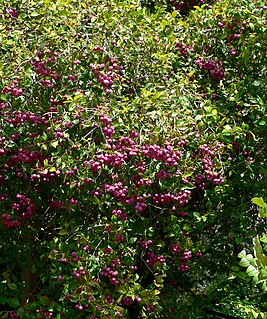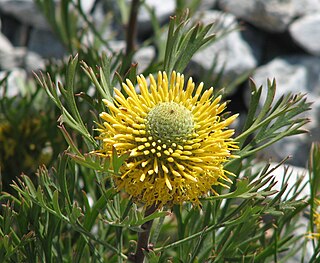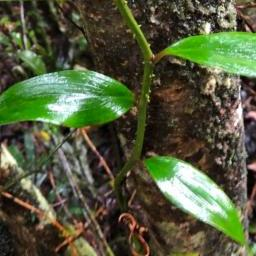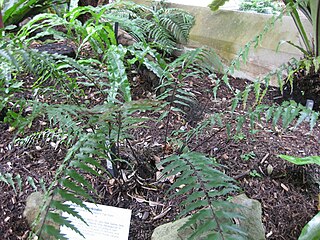Related Research Articles

Shrubland, scrubland, scrub, brush, or bush is a plant community characterized by vegetation dominated by shrubs, often also including grasses, herbs, and geophytes. Shrubland may either occur naturally or be the result of human activity. It may be the mature vegetation type in a particular region and remain stable over time, or a transitional community that occurs temporarily as the result of a disturbance, such as fire. A stable state may be maintained by regular natural disturbance such as fire or browsing. Shrubland may be unsuitable for human habitation because of the danger of fire. The term was coined in 1903.

Nothofagus moorei, commonly known as Antarctic beech, is an important Gondwana relict of the rainforests of the southern hemisphere. It occurs in wet, fire-free areas at high altitude in eastern Australia.

Syzygium smithii is a summer-flowering, winter-fruiting evergreen tree, belonging to the myrtle family Myrtaceae. It shares the common name "lilly pilly" with several other plants. In New Zealand, it is commonly known as 'monkey apple'. It is planted as shrubs or hedgerows, and features: rough, woody bark; cream and green smooth, waxy leaves; flushes of pink new growth; and white to maroon edible berries. Unpruned, it will grow about 3–5 m (9.8–16.4 ft) tall in the garden.

Harpullia is a genus of about 27 species of small to medium-sized rainforest trees from the family Sapindaceae. They have a wide distribution ranging from India eastwards through Malesia, Papuasia and Australasia to the Pacific Islands. They grow naturally usually in or on the margins of rainforests or associated vegetation.

Ripogonum is a genus of flowering plants confined to eastern Australia, New Zealand, and New Guinea. Until recently this genus was included in the family Smilacaceae, and earlier in the family Liliaceae, but it has now been separated as its own family Ripogonaceae.

Eidothea is a genus of two species of rainforest trees in New South Wales and Queensland, in eastern Australia, constituting part of the plant family Proteaceae. The plant family Proteaceae was named after the shape-shifting god Proteus of Greek mythology. The genus name Eidothea refers to one of the three daughters of Proteus.

Tasmannia stipitata, commonly known as the Dorrigo pepper or northern pepperbush is a rainforest shrub of temperate forests of the Northern Tablelands of New South Wales, Australia. Leaves are fragrant, narrow-lanceolate to narrow-elliptic, 8–13 cm long. Dark bluish to mauve berries follow the flowers on female shrubs. The species is dioecious, with male and female flowers on separate plants.

Isopogon anemonifolius, commonly known as broad-leaved drumsticks, is a shrub of the family Proteaceae that is native only to eastern New South Wales in Australia. It occurs naturally in woodland, open forest, and heathland on sandstone soils. I. anemonifolius usually ranges between one and two metres in height, and is generally smaller in exposed heathland. Its leaves are divided and narrow, though broader than those of the related Isopogon anethifolius, and have a purplish tinge during the cooler months. The yellow flowers appear during late spring or early summer and are displayed prominently. They are followed by round grey cones, which give the plant its common name drumsticks. The small hairy seeds are found in the old flower parts.

Callitris macleayana is a species of conifer in the family Cupressaceae, endemic to Australia. The tree is commonly known as stringybark pine, as well as brush cypress pine and Port Macquarie pine, although it does not belong to the pine genus or family. Stringybark pine is found in two regions of Australia's East coast, one in the centre and one in the North.

Eidothea hardeniana, commonly named nightcap oak, is a species of tree, up to 40 m (130 ft) tall, of the plant family Proteaceae, which botanist Robert Kooyman recognised as a new species only recently in 2002. The species has an official listing as critically endangered on the Australian Commonwealth EPBC Act and as Endangered on the NSW Threatened Species Act. The name hardeniana honours the botanist Gwen Harden. Phylogenetics studies now suggest it represents a basal branch of the Proteoid clade of the Proteaceae.

Euryops chrysanthemoides is a small shrub native to Southern Africa that is also grown as a horticultural specimen in tropical to subtropical regions around the world.

Petermannia is the sole genus of plants in the family Petermanniaceae. Petermannia cirrosa, the only species in the genus, is endemic to the states of New South Wales and Queensland in Australia. it is a prickly, wiry stemmed vine which grows to 6 metres in height and has lancelote, ovate or elliptic leaves with an acute apex. The flowers, which appear during summer, have reflexed reddish green or white tepals. These are followed by rounded red berries.

Asplenium polyodon, commonly known as sickle spleenwort, is a species of fern in the family Aspleniaceae. The distribution of A. polyodon includes parts of the countries of Australia and New Zealand. A specific locale of occurrence is in forested areas of Westland, New Zealand, where associate understory species include crown fern.

Eidothea zoexylocarya is a species of tall rainforest trees endemic to north-eastern Queensland, Australia and constituting part of the plant family Proteaceae. In European–Australian science, these trees were only recognised in recent decades, first from the slopes of Mount Bartle Frere, the Queensland mountain which reaches the highest altitude. In 1995, scientific descriptions of the trees, as this genus and type species, were published for the first time by Andrew W. Douglas and Bernie Hyland. The species name refers to the almost identical fossil fruit Xylocaryon lockiiF.Muell., from Ballarat, southern Australia, still extant in this north-eastern Australian species.

Lomatia myricoides, commonly known as the river lomatia, is a shrub native to New South Wales and Victoria in southeastern Australia.

Lomatia arborescens, commonly known as smooth lomatia or tree lomatia, is a shrub or small tree that grows at high altitudes, in and near rainforests. It is found north from the Barrington Tops area in eastern Australia.

The National Herbarium of New South Wales was established in 1853. The Herbarium has a collection of more than 1.4 million plant specimens, making it the second largest collection of pressed, dried plant specimens in Australia, including scientific and historically significant collections and samples of Australian flora gathered by Joseph Banks and Daniel Solander during the voyage of HMS Endeavour in 1770.

Persoonia terminalis, also known as the Torrington geebung, is a shrub belonging to the family Proteaceae, and native to northern New South Wales and southern Queensland in eastern Australia. Reported as a subspecies of Persoonia nutans in 1981, it was described as a species by Lawrie Johnson and his colleague Peter Weston in 1991.

Isopogon mnoraifolius is a shrub of the family Proteaceae and is endemic to New South Wales.

Roger Charles Carolin is a botanist, pteridologist and formerly an associate professor at Sydney University. He was appointed as a lecturer in botany at the University of Sydney in 1955 earned a Ph.D from Sydney University in 1962 with a thesis on the floral morphology of the campanales, and retired as an associate professor in 1989.
References
- ↑ Harden, G. J. (Gwenneth Jean) (1990), Flora of New South Wales, NSW University Press, ISBN 978-0-86840-188-1
- ↑ Harden, G. J. (Gwenneth Jean) (2000), Flora of New South Wales (Rev. ed.), Kensington, N.S.W. UNSW University Press, ISBN 978-0-86840-188-1
- ↑ "Eidothea hardeniana". PlantNet -New South Wales Flora Online. Retrieved 7 May 2020.
- ↑ "Harden, Gwenneth J. (1940-)". International Plant Name Index. Retrieved 7 May 2020.
- ↑ IPNI. G.J.Harden.